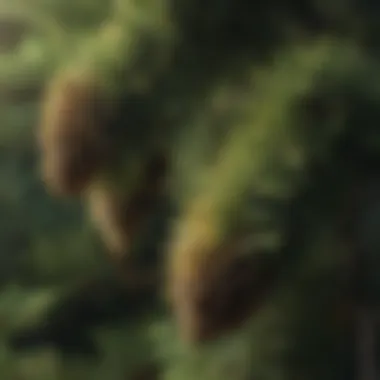Exploring Juniperus Monosperma: Ecology and Conservation


Intro
Juniperus monosperma, commonly known as one-seed juniper, is a significant tree species that thrives in the arid regions of the southwestern United States and northern Mexico. This article aims to provide a thorough analysis of the species, shedding light on its ecological roles, habitat preferences, and conservation measures. Understanding the intrinsic value of Juniperus monosperma leads to better management practices, fostering sustained growth and biodiversity in its environment.
Overview of Forestry Practices
Definition of Forestry
Forestry encompasses the science and art of managing forested landscapes. It integrates conservation, sustainable practices, and land management, aiming for ecological balance while yielding economic benefits. Successful forestry involves understanding the interconnections within ecosystems including plant life, wildlife, soil, and climate.
Importance of Forestry in Ecosystem Management
Forestry plays a crucial role in maintaining ecological integrity. Healthy forests regulate water cycles, improve air quality, and provide crucial habitats for diverse species, including plants and animals. They also act as carbon sinks, mitigating climate change. Understanding forestry practices is vital for professionals engaged in the management and conservation of Juniperus monosperma.
Sustainable Forest Management
Principles of Sustainable Practices
Sustainable forest management is rooted in a few key principles:
- Ecosystem Health: Maintaining biodiversity and ecosystem services.
- Resource Efficiency: Minimizing waste in management practices.
- Social Responsibility: Engaging local communities in stewardship and monitoring.
- Economic Viability: Ensuring forest resources contribute to the local and regional economy.
Techniques in Sustainable Management
Adopting specific techniques is essential for enhancing sustainability. Some effective methods include:
- Selective Logging: Removing certain trees while preserving the overall structure of the forest.
- Reforestation Projects: Planting native species to restore degraded areas.
- Thinning Practices: Reducing tree competition to promote healthier growth.
These approaches ensure that forestry can be both productive and sustainable, allowing for species like Juniperus monosperma to flourish.
Woodland Stewardship Strategies
Importance of Woodland Stewardship
Woodland stewardship involves responsible management practices aimed at preserving forest ecosystems for future generations. Given the ecological importance of Juniperus monosperma, implementing stewardship strategies can greatly enhance its preservation and the surrounding biodiversity.
Best Practices for Landowners
Landowners can adopt best practices to support woodland stewardship:
- Engagement with Experts: Collaborate with forestry professionals for tailored advice.
- Monitoring Ecosystem Health: Regularly assess the health of the forest and its species.
- Community Involvement: Foster awareness and participation among local communities.
By employing these practices, landowners contribute significantly to the effective management of Juniperus monosperma, ensuring its continued relevance in the ecosystem.
Prelude to Juniperus Monosperma
The Introduction to Juniperus monosperma sets the foundation for understanding this significant species. Juniperus monosperma, commonly known as one-seed juniper, is more than just a tree; it plays a critical role in its native ecosystem. Recognizing its importance helps to inform sustainable practices and proper management. Through the sections that follow, we will delve deep into various aspects of this species, which are crucial for forestry professionals and academics.
Taxonomy and Classification
Juniperus monosperma belongs to the family Cupressaceae, which is often recognized for its conifers. This species is categorized within the genus Juniperus, which comprises aromatic shrubs and trees. The classification system provides a framework that helps understand this species' characteristics and its relationship with other plants. This specific juniper is usually identified by its unique morphology, including needle-like foliage and berry-like cones. Such classification aligns with our understanding of plant biodiversity and the roles that various species play in their habitats. Taxonomic knowledge is essential for conservation efforts, as it helps identify genetic variations and ecological niches that might need protection.
Geographical Distribution
The geographical distribution of Juniperus monosperma primarily covers the southwestern United States and northern Mexico. It thrives in arid environments, often found at elevations ranging from 1,000 to 2,200 meters. Typical regions include the expanses of New Mexico, Arizona, and parts of Texas and Mexico. Understanding this distribution aids in recognizing the ecological requirements of the species, as well as its resilience to varied climatic conditions.
The tree often grows in rocky or sandy soils, conditions that might seem harsh for other species. These unique preferences make it crucial for the ecosystems of these dry regions. This tree not only provides essential habitats for wildlife but also influences soil quality and composition. Knowing its geographical reach enables better conservation management, ensuring this vital species is well-preserved against changing environmental conditions.
Morphological Characteristics
Understanding the morphological characteristics of Juniperus monosperma is essential for assessing its ecological role and adaptability. The features of this species provide insights into how it interacts with its environment and supports the ecosystem. Its physical and reproductive traits are vital for ensuring its survival and propagation, directly influencing its distribution and abundance.
Physical Characteristics


Height and Size
Juniperus monosperma typically reaches heights between 10 to 15 meters. This range offers a suitable presence in its native habitat, allowing it to access sunlight while competing for space among other flora. Its height makes it a notable component of the landscape, providing shelter and resources for wildlife. The size contributes to its role as a keystone species in arid environments, fostering biodiversity. The tree's substantial height allows it to resist drought by extending its roots deeper into the soil.
Bark Texture
The bark of Juniperus monosperma is another significant characteristic. It is fibrous and scaly, providing a protective layer against harsh weather conditions and pests. This unique texture assists in moisture retention, which is crucial in its native dry climates. The bark not only serves a practical purpose but also adds aesthetic value that can enhance landscaping designs. It's beneficial choice for xeriscaping and similar landscaping efforts, due to its clarity and resilience against the elements.
Leaf Structure
The leaf structure of Juniperus monosperma reflects its adaptation to its environment. The foliage is made up of scale-like leaves that are small and green, effectively minimizing water loss. This characteristic allows the tree to thrive in areas with limited rainfall. The leaves also play a vital role in photosynthesis, ensuring the tree's growth and longevity. Their arrangement can create a dense cover, beneficial for wildlife seeking habitat.
Reproductive Features
Flowering Phenology
The flowering period of Juniperus monosperma is typically noted in late spring. This timing corresponds with favorable weather conditions that promote pollination. Its reproductive strategy allows for effective seed production at a moment when environmental conditions are optimal for germination. The species is dioecious, meaning that individual trees are either male or female. This separation enables a genetic diversity that can enhance the resilience of its population.
Seed Dispersal Mechanisms
Seed dispersal is crucial for the proliferation of Juniperus monosperma. The tree produces fleshy, berry-like cones that attract birds and other animals. These creatures eat the cones, and their digestive processes help to scatter the seeds over a wide area. This method of dispersal promotes genetic exchange and colonization of new habitats, allowing for a more dynamic population. The successful spread of seeds is essential for the sustainability of the species, especially in changing environments.
Ecological Role
The ecological role of Juniperus monosperma transcends mere botanical classification. It serves as a keystone species within its native habitats, influencing various ecological interactions. Primarily, this tree significantly shapes the landscape architecture, facilitating soil stabilization and providing microhabitats for numerous organisms. Its adaptability to diverse environments highlights its importance in maintaining the balance within ecosystems.
Habitat Preferences
Soil Types
Juniperus monosperma exhibits a strong preference for well-drained soil types. Sandy to loamy soils are particularly suitable as they allow proper aeration and drainage. These soils prevent waterlogging, which can be detrimental to root health.
The key characteristic of these soil types is their nutrient composition, which is vital for the tree's growth. Sandy soils, while less rich in nutrients, promote extensive root systems capable of reaching deeper moisture reserves. This feature ensures the tree's survival during dry seasons, making it a popular choice for arid landscapes in the Southwestern United States.
However, the disadvantage is that overly sandy soils may require additional organic matter to enhance fertility. The holistic approach to soil management around Juniperus monosperma involves considering these factors to maintain healthy growth and ecological stability.
Climate Requirements
Juniperus monosperma thrives in semi-arid to arid climates, demonstrating resilience against drought conditions. This tree species generally requires a temperate climate with low annual rainfall ranging from 12 to 20 inches. This climate preference significantly contributes to its establishment in Southwestern deserts and foothills.
The ability to adapt to extreme temperature variations is another key characteristic. While it can endure high temperatures during the day, Juniperus monosperma also withstands colder nights. This variability is beneficial for its growth and distribution in marginal environments.
Nonetheless, this adaptability also poses risks, notably from climate change. Increasing temperature extremes may limit its natural range, affecting its ecological role and the services it provides in its habitat.
Associations with Wildlife
Habitats for Fauna
Juniperus monosperma is vital for various wildlife species. Its dense foliage creates essential habitats that protect birds, mammals, and insects. The tree itself offers nesting sites, while its seeds serve as a food source for numerous species. This dual role enhances biodiversity in its ecological niche.
The key characteristic of these habitats is their structural complexity. The tree's branching patterns provide diverse layers for different wildlife species, catering to various ecological requirements. This complexity makes it an effective choice for promoting ecosystem health and resilience.
Yet, habitat fragmentation poses a significant threat to these ecological benefits. As human activities increase, the habitat provided by Juniperus monosperma can diminish, leading to a decline in associated fauna populations.
Mutualistic Relationships
The mutualistic relationships established by Juniperus monosperma illustrate its ecological significance. This tree is known to form symbiotic associations with mycorrhizal fungi, enhancing nutrient absorption. The fungi assist the tree in obtaining minerals from the soil, while the tree provides carbohydrates, creating a beneficial cycle.
A key characteristic of these relationships is their dependency on environmental conditions. For example, the success of these mutualisms is often influenced by soil moisture levels and nutrient availability. This adaptability enriches the understanding and importance of these dynamics in ecosystem management.
However, these mutualistic interactions can be sensitive to environmental changes. When soils become degraded or when climate conditions shift unfavorably, these relationships may weaken, undermining the health of both Juniperus monosperma and associated organisms.
Cultural Significance


Understanding the cultural significance of Juniperus monosperma is essential to fully appreciate its role in both historical and contemporary contexts. This species has been integral to various communities, especially those found in the southwestern United States and northern Mexico. The utilization of Juniperus monosperma ranges from practical applications to spiritual practices, showcasing its multifaceted impact.
Historical Uses by Indigenous Peoples
Culinary Applications
The culinary applications of Juniperus monosperma by indigenous peoples highlight its importance as a food source. The berries from the tree are often used in traditional dishes, contributing unique flavors and nutrition. These berries are not only edible but are known for their slightly sweet and tart taste. They can be used in making jams, jellies, and even alcoholic beverages, such as gin. The practice of utilizing these berries connects communities with their environment, teaching them the value of local resources.
The key characteristic of these culinary uses is their sustainable nature. Indigenous peoples have developed methods to harvest berries without depleting the tree’s capacity to regenerate. This promotes a harmonious relationship with the ecosystem.
However, it is vital to recognize potential disadvantages. Overharvesting or targeting only the tree's berries might threaten its survival. Therefore, awareness and careful practices are necessary to ensure a balance between use and conservation.
Medicinal Uses
Another significant aspect of Juniperus monosperma is its history in traditional medicine. Indigenous peoples have employed various parts of the tree for medicinal purposes. For instance, infusions made from its leaves are believed to provide relief from certain ailments such as respiratory issues or gastrointestinal discomfort.
The key characteristic of these medicinal uses is the diversity of applications. The plant offers antiseptic properties that can be harnessed for treating wounds or infections. Additionally, the essential oils derived from the tree are noted for their potential anti-inflammatory effects.
Nevertheless, it is essential to consider that some of these traditional practices may lack modern scientific validation. While there are anecdotal benefits, rigorous studies are needed to confirm the efficacy and safety of these uses.
Contemporary Uses in Landscaping
Aesthetic Qualities
In contemporary times, Juniperus monosperma is increasingly valued for its aesthetic contributions to landscaping. The tree's unique form, characterized by its dense foliage and rugged bark, offers a visually appealing option for various outdoor settings.
One of the key characteristics is its adaptability to different landscape designs. Its natural beauty can enhance both commercial and residential areas, making it a popular choice among landscape architects and designers. The presence of these trees can also provide a sense of timelessness and connection to the natural world, which is often sought after in modern urban settings.
However, it is important to choose the right location for planting. This tree requires adequate space to grow and may not thrive in overly compacted environments. Consideration for proper placement will ensure its long-term health and aesthetic appeal.
Functional Uses
Beyond aesthetics, Juniperus monosperma serves several functional purposes in landscaping, which are increasingly recognized by professionals in the field. Its ability to provide shade helps improve energy efficiency in buildings by reducing cooling costs. Moreover, its root system is beneficial for preventing soil erosion, contributing to long-term landscape stability.
The key characteristic that supports these functional uses is its drought tolerance. In many arid regions, this tree can thrive with minimal water, making it a viable choice for sustainable landscaping practices. This not only conserves water but also supports ecosystems by maintaining soil health.
However, it is essential to monitor its growth. In some cases, if not managed properly, it can become invasive in certain environments, outcompeting local flora. Hence, responsible planning is necessary to maximize its benefits while mitigating potential ecological impacts.
Understanding the cultural significance of Juniperus monosperma offers valuable insights into its historical and contemporary relevance, ultimately guiding sustainable practices in management and usage.
Conservation and Threats
The conservation of Juniperus monosperma is essential given its ecological significance and the various threats it faces. Understanding these threats helps in developing effective management strategies that can ensure the sustainability of this species. Conservation practices are vital not only for the tree itself but also for the myriad of species that depend on it for their habitat and food sources. This section examines the current conservation status of Juniperus monosperma and the significant threats to its survival.
Current Conservation Status
Juniperus monosperma is classified as a species of least concern by conservation authorities, indicating that it is currently not facing immediate extinction threats. However, localized populations may experience pressures from land development and environmental changes. Various conservation efforts have been initiated to monitor the health and sustainability of these trees across their native range in the southwestern United States and northern Mexico. Continuous assessment of forest health is necessary, as changing environmental conditions could alter their current status.
Threats to Survival
Both natural and anthropogenic factors threaten the survival of Juniperus monosperma. Awareness of these factors can inform better conservation practices.
Climate Change Impacts
Climate change presents a significant challenge to Juniperus monosperma. Rising temperatures and altered precipitation patterns jeopardize its habitat. Specifically, increased drought conditions can affect tree growth and reproduction, leading to reduced population resilience. The extreme weather associated with climate variability is a key characteristic of this threat, making it particularly relevant for this discussion. Monitoring temperature and precipitation data, alongside the tree's growth patterns, can help in understanding how these changes affect its survival. The unique feature of climate change is its far-reaching impact on both the individual species and the broader ecosystem, making it a critical area of focus in conservation strategies.
Habitat Destruction
Habitat destruction is another pressing threat faced by Juniperus monosperma. Urbanization, agriculture, and resource extraction lead to significant loss of suitable habitats. The clearing of land not only reduces the number of trees directly but also disrupts the ecosystems that rely on them, affecting numerous species of wildlife. A crucial aspect of habitat destruction is the fragmentation of remaining habitats, which can isolate populations of Juniperus monosperma, making it difficult for them to thrive or reproduce. Consequently, understanding the implications of habitat loss is vital for the effective management of this species and planning sustainable land use practices.
Sustainable Management Practices
Sustainable management practices are crucial in maintaining the health and viability of Juniperus monosperma populations. This tree species plays a significant role in its ecosystem, and proper management ensures it can thrive in its native environments. Implementing these practices guarantees not just the survival of this species, but also the preservation of the biodiversity associated with it. Sustainable practices help mitigate threats like habitat loss and climate change, which can jeopardize the integrity of its population.


Best Practices for Cultivation
Soil Management
Soil management is a critical aspect of sustainable agriculture. For Juniperus monosperma, effective soil management contributes to healthy plant growth and resilience against environmental stresses.
A key characteristic of soil management is maintaining proper pH and nutrient levels. This is beneficial because balanced soil conditions enhance root development and overall vitality of the tree.
An unique feature to consider in soil management is the importance of organic matter. Organic content improves soil structure, which can lead to better water retention. However, improper balance can lead to excess nutrients, which may harm the tree in its growth.
Water Conservation
Water conservation directly affects the success and sustainability of Juniperus monosperma. In arid regions where this tree thrives, effective water management can be the difference between survival and decline. A major benefit of water conservation is that it allows for consistent growth even during drought conditions.
Rainwater harvesting systems, for example, can be an effective method of conserving water. This unique feature provides an alternative water source during dry spells. Nevertheless, over-reliance on artificial systems can have disadvantages, such as increased costs and maintenance efforts over time.
Community Involvement in Stewardship
Community involvement in stewardship plays an essential role in the sustainable management of Juniperus monosperma. Engaging local communities strengthens conservation efforts and fosters a sense of responsibility towards this vital species. Understanding the local context can lead to more effective management strategies tailored to community needs.
Educational Outreach
Educational outreach is vital for raising awareness about the importance of Juniperus monosperma and the ecosystems it supports. It contributes significantly to fostering a knowledgeable and engaged public. A key characteristic is that it empowers individuals with the knowledge required for effective conservation.
By providing education on the tree's ecological functions and management practices, communities develop a deeper connection. However, the challenge lies in ensuring the information delivered is accurate and accessible to all.
Volunteer Programs
Volunteer programs encourage hands-on involvement from community members in the care and management of Juniperus monosperma. Such programs illustrate the collective effort needed to sustain the species. A key characteristic is that volunteering fosters a sense of ownership and commitment to local natural resources.
One unique feature of volunteering is the social aspect it brings. Community members often bond through shared activities, enhancing community ties and participation. The disadvantage may occur if programs are not well-organized, leading to burnout among volunteers and ineffective outcomes.
Future Research Directions
Research on Juniperus monosperma is crucial for advancing our understanding of this species’ role within its ecosystem. As environmental conditions shift, it is vital to explore the gaps in our knowledge and to develop innovative conservation strategies that address both current and future challenges. This section will emphasize two primary elements: the identification of areas that require further research and the implementation of novel approaches for conservation and management. The intention is to foster a deeper understanding of how Juniperus monosperma can be preserved for future generations, ensuring that it continues to thrive in its native habitats.
Gaps in Knowledge
Genetic Diversity Studies
Studying the genetic diversity of Juniperus monosperma offers insight into its adaptability and resilience in changing environments. This focus is important as genetic variability contributes to the overall health of populations. A diverse gene pool enhances the tree's ability to withstand diseases and pests, variations in climate, and other stressors. By understanding its genetic makeup, we can better predict how this species will respond to future challenges.
Key features of genetic diversity studies include assessing different populations within its range and identifying markers associated with resistance to specific environmental pressures. This research choice is beneficial because it can lead to improved conservation techniques and informed management practices.
However, research in this area poses some challenges. Fieldwork to collect genetic samples can be resource-intensive and may require permissions from landowners or indigenous groups. Furthermore, interpreting genetic data requires advanced technology and expertise, which can be limiting factors. Despite these disadvantages, the outcomes can significantly enhance knowledge about the species and guide effective conservation strategies.
Climate Adaptability Research
The study of climate adaptability in Juniperus monosperma directly correlates with its survival as global temperatures rise. This type of research assesses how the tree responds to changing climate variables, including temperature fluctuations and altered precipitation patterns. Examining these elements can provide critical data for predicting the future distribution of the species.
The key characteristic of climate adaptability research is its emphasis on understanding physiological responses to environmental changes. This characteristic makes it a valuable focus for researchers interested in the implications of climate change on forest ecosystems. Understanding how Juniperus monosperma may cope with changes will inform conservationists and forestry professionals on its management under stress conditions.
The unique feature of this research is its capacity to link ecological studies with climatic models to provide a comprehensive view of potential survival strategies. However, a limitation is the inherent unpredictability of future climate scenarios, which can complicate projections. Yet, this unpredictability also highlights the urgent need for research in this area.
Innovative Conservation Strategies
Technology in Monitoring
Monitoring the health and spread of Juniperus monosperma using cutting-edge technology represents a significant advancement in conservation strategies. Techniques such as drone surveillance, remote sensing, and GIS mapping can be employed to assess and monitor tree populations effectively. These tools allow for real-time data collection and analysis, providing timely insights into changes in tree health and environmental conditions.
The key advantage of applying technology in monitoring efforts is the increase in efficiency and accuracy of data gathering. This capability enables researchers and conservationists to detect shifts in population dynamics and habitat conditions that may go unnoticed through traditional methods. Moreover, data can be shared rapidly among stakeholders, facilitating swift decision-making.
Nonetheless, reliance on technology can pose challenges. Not all regions have access to necessary resources to implement such solutions, and training personnel to use advanced technology can require significant investments. However, the benefits of enhanced monitoring capabilities outweigh these drawbacks as it enables better-informed conservation strategies.
Community-Based Conservation
Community-based conservation approaches highlight the importance of involving local communities in the stewardship of Juniperus monosperma. This strategy emphasizes collaboration between researchers, local residents, and conservation advocates, fostering a sense of ownership and responsibility towards the environment. Such partnerships can lead to successful implementation of conservation initiatives, as community members often have valuable local knowledge.
A key characteristic of this approach is its reliance on local engagement and education. When communities are informed about the ecological significance of Juniperus monosperma and its threats, they are more likely to participate actively in conservation efforts. This grassroots involvement can lead to sustainable management practices that effectively support the species and its habitat.
However, challenges can arise in balancing diverse interests within the community. Conflicting priorities may hinder the adoption of conservation practices. There is a need for effective communication and negotiation among stakeholders to help mitigate these conflicts. Despite potential hurdles, community-based conservation remains an innovative and effective way to bolster efforts towards preserving Juniperus monosperma for future generations.







